
API (application programming interface) documentation is the backbone of tech and software development. API providers must deliver clear and consistently updated documentation to keep users informed and help them avoid programming errors.
Now more than ever, companies are interested in offering state-of-the-art documentation as part of their API management strategy. This also includes aspects like API security, monitoring, and analytics. A recent Traceable report forecasts a substantial 34% compound annual growth rate (CAGR) for the API management market.
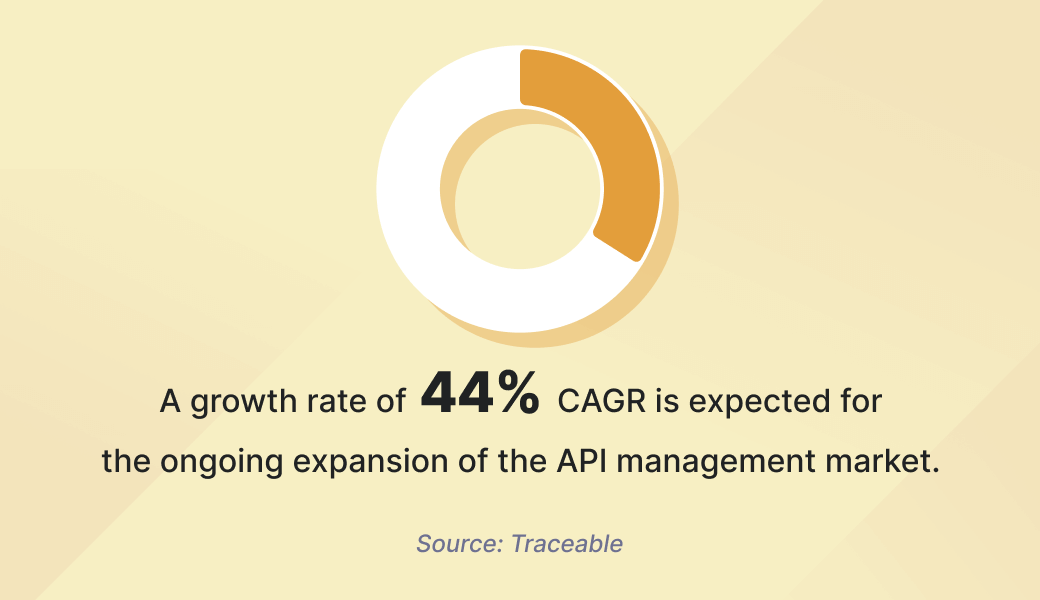
This guide explores the key insights into creating API documentation. From practical writing tips to user-centric strategies, it aims to give you the knowledge to develop your own API documentation with minimal effort.
What is API documentation?
API documentation serves as a guidebook detailing the usage of an API and its services. Within this manual, users can find:
- Tutorials
- Screenshots
- Code snippets
- Other resources to understand API operations
Think of API documentation as a pact between two parties. This clarifies how the second party and its software will react upon receiving specific requests from the first party. These requests are commonly known as API calls, guiding developers on the available functionalities and their implementation.
🔚 Effective API documentation outlines endpoints and explains why and when to use them. It goes a step further by providing precise examples catering to users with various levels of knowledge.
Types of API documentation
Understanding the types of API documentation ensures good communication between developers and those using the APIs. Each type has a unique role, providing information at different stages of development:
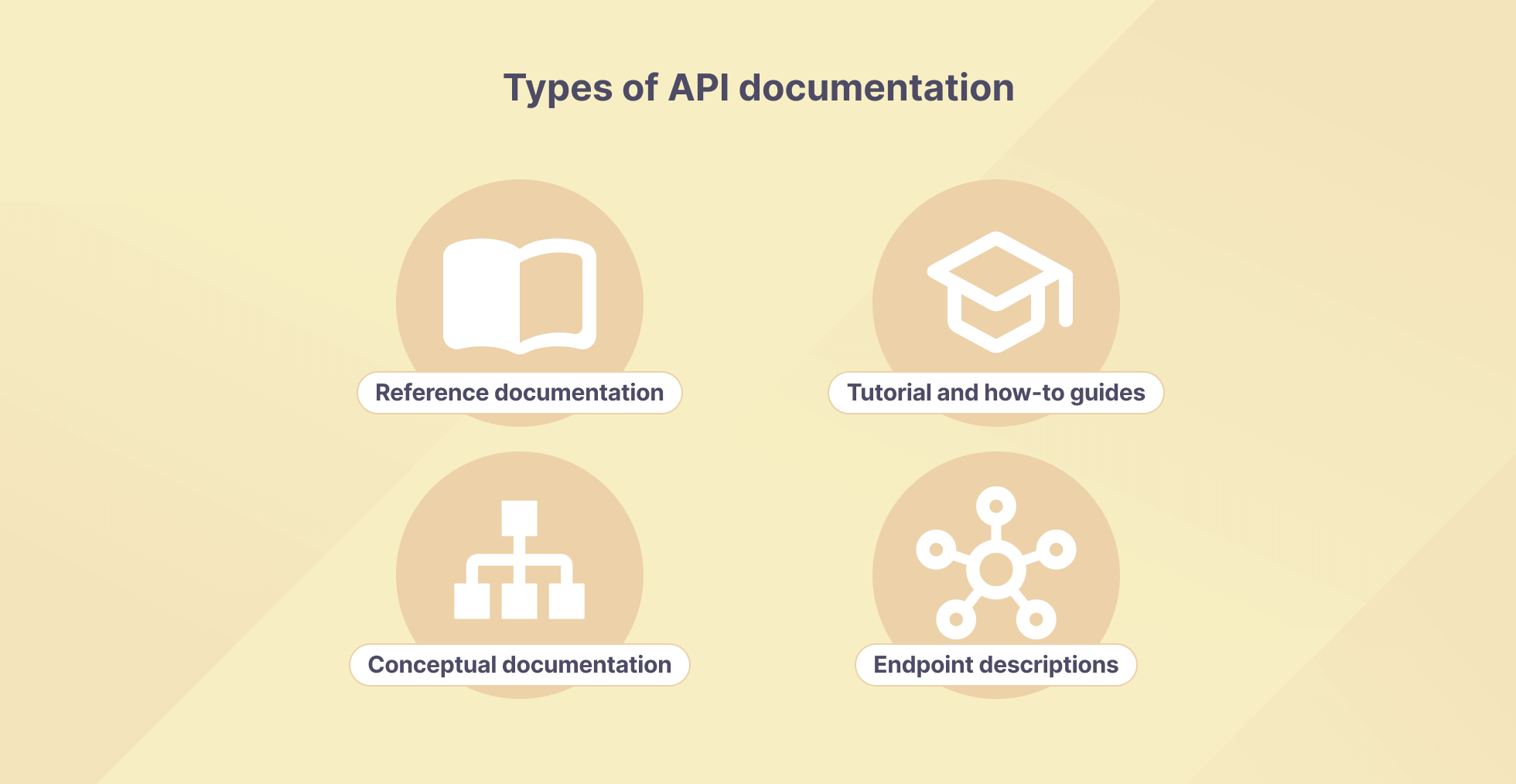
- Reference documentation explains the functionalities and parameters of an API. Developers refer to it when they need detailed specifications or technical insights into API usage.
- Tutorials and how-to guides offer a structured approach to using specific API features. These documents are useful to users who seek practical advice and examples on how to implement API functionalities.
- Conceptual documentation contains the main principles of the API. It gives users a deeper understanding of the API’s logic and structure.
- Endpoint descriptions provide insights into API endpoints. They describe what the API does, what it needs for input, and what results to expect. This documentation assists developers in adding specific features or understanding the API’s capabilities.
Why document APIs?
Here are some of the benefits of documenting APIs clearly.
- Improved user experience and developer productivity: Developers can effortlessly understand the API’s functionalities if the information is concise and accessible.
- More efficient integration and adoption: Detailed API documentation makes it easier for developers to adopt and incorporate the API into their applications.
- Enhanced maintainability and scalability: Developers can then better grasp how the API works. This helps them fix issues, make changes, and keep the system stable over time.
How to write API documentation in seven steps
Follow this procedure to write comprehensive, user-friendly API documentation.
1. Understand your audience
Knowing your audience helps determine the amount of detail and technical jargon to include in the documentation.
Begin by identifying the main users of your documentation. Consider two main groups:
- Regular API users — developers who seek tutorials and code examples
- Seasoned API users — users who evaluate the API’s pricing, limits, and security, like product managers or CTOs (chief technology officers)
🪡 Tailor your documentation by recognizing the intended users’ level of expertise. Keep it to the point by focusing on fundamental explanations for newcomers. If you think more experienced developers will be using the documentation, you can delve into advanced concepts.
2. Outline the basics
Different APIs serve various purposes, such as offering traffic updates in navigation apps or music recommendations in streaming apps.
Despite this diversity, every API documentation should cover some fundamental aspects.
- Start the documentation with an overview of the API.
- Include its purpose, key features, and any background information necessary for understanding its use.
3. Provide authentication guidelines
If your API requires authentication, you need to offer users clear authentication guidelines.
Consider the following tips when explaining the authentication process.
- Include code examples demonstrating the correct format for API keys or tokens.
- Clarify the expiration and renewal processes for authentication credentials.
When APIs employ multiple authentication methods, the documentation must explain each method. For instance, the YouTube Data API gives users several authentication choices by supporting OAuth 2.0 and API keys.
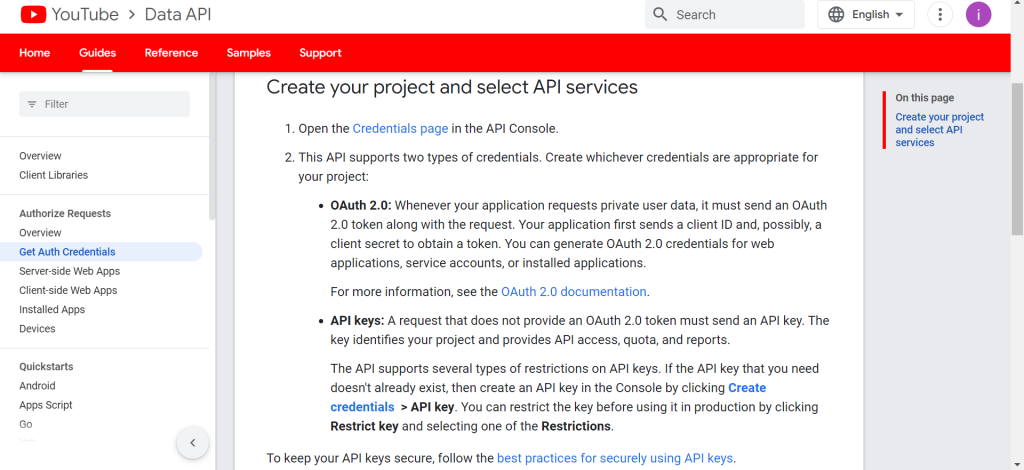
Image source: developers.google.com
4. Document endpoints and methods
Documenting endpoints and methods ensures standardization across API use. It helps save time for both the API developers and the users.
- Don’t forget the URL when documenting endpoints.
- Specify the HTTP method — GET, POST, PUT, or DELETE — to guide users during their interactions with the API.
- Include details on required and optional parameters to help users tailor their requests.
- Document potential error codes and corresponding messages for a more user-friendly experience.
5. Include real-life examples
Provide practical instances that show users how to make requests and handle responses. This way, developers can better understand the main functions of each API endpoint. It can also give them a starting point with customizable code.
🪧 These examples become even more helpful as they demonstrate how the API works in real-world situations.
6. Detail error handling
Think of this as giving users a map to navigate through potential roadblocks. This way, users can troubleshoot issues effectively and have glitch-free interactions with your API.
Detailing error handling involves a three-step process:
- Break down common errors
- Explain what each error code means
- Guide users on how to fix them
🛠️ Sharing status and error codes helps developers and testers prepare for updates.
7. Mention any limitations on API usage
Inform users about any limitations your API may have. Clearly describe factors like rate limits or quotas to clarify the constraints they may face.
For instance, take rate limiting — a technique that prevents the accidental or intentional abuse of an API. Your documentation should clearly articulate rate limits, usually within the terms of use. Facebook Graph API is a good documentation example that explicitly communicates its limits.
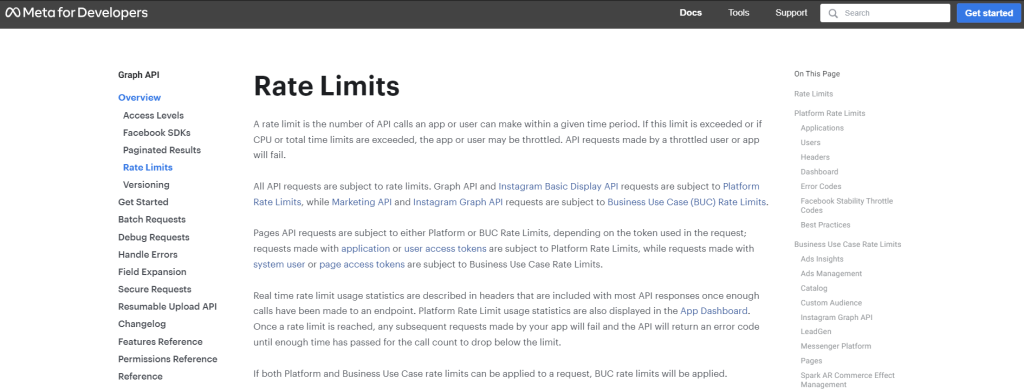
Image source: developers.facebook.com
🚧 Your documentation should also explain how these limitations are enforced and reported. This allows users to understand what to expect from the API and adapt its usage accordingly.
Best API documentation tools
Several tools are available for creating API documentation. We’ve highlighted three of the best.
ReDoc
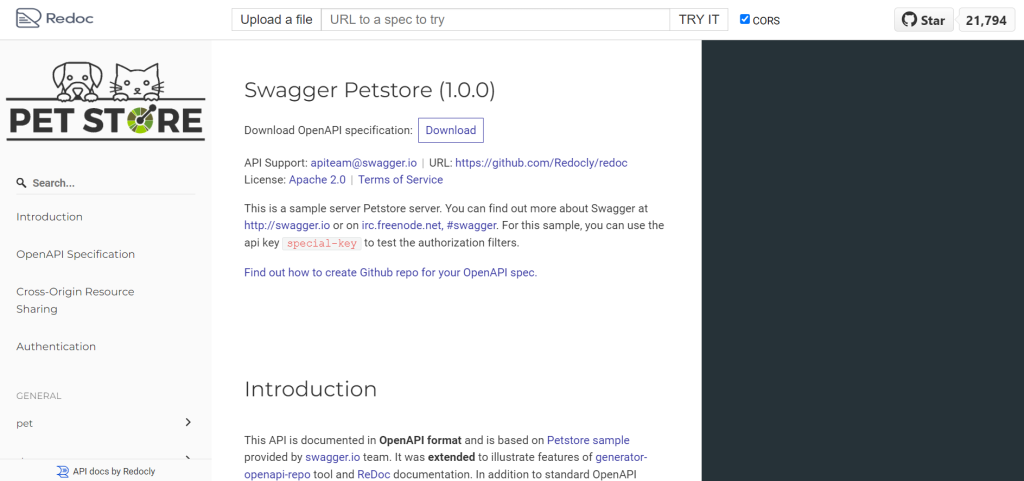
Image source: redocly.github.io/redoc
ReDoc, an open-source documentation tool supporting OAS 2.0 and OAS 3.0, empowers businesses to publish interactive API documentation online.
Key features and benefits
- Versatile operation: ReDoc seamlessly operates within browsers and extends its functionality as a Docker image, React component, or command-line tool.
- Responsive design: The theme captivates visually and ensures full responsiveness, adapting to diverse screen sizes and browsers. Users can personalize their experience by customizing fonts and colors and by integrating logos.
- Effortless navigation: ReDoc simplifies the user experience with a customizable navigation bar and search box, allowing users to find the information they need easily.
Theneo
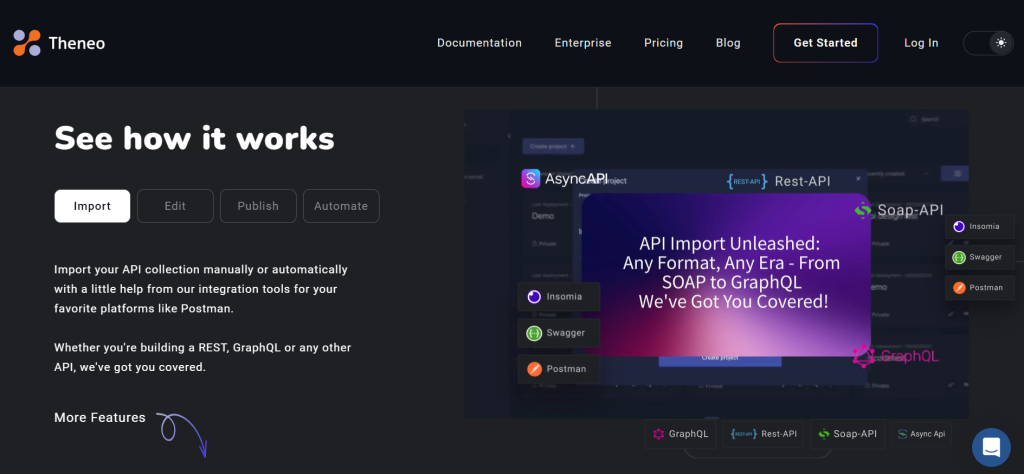
Image source: theneo.io
Theneo is an API documentation generation tool. It employs AI-generated descriptions and summaries, eliminating the need for manual effort.
Key features and benefits
- User-friendly interface: The intuitive, Notion-like environment allows users to navigate and interact with the documentation generation tool.
- Automated language conversion: Theneo simplifies the process by automatically converting requests into multiple programming languages. This provides flexibility and convenience for users with diverse language preferences.
- Enhanced collaboration: It facilitates collaboration by offering features like importing API collections and receiving feedback.
- Seamless integration: Theneo integrates effortlessly with popular tools such as Swagger, Postman, and GitHub, ensuring synergy with existing developer workflows.
Swagger UI

Image source: swagger.io
Swagger UI is a tool that is effective in developing interactive API documentation. It simplifies the process for users by transforming OpenAPI Specification (OAS) documents into visually appealing content using HTML, JavaScript, and CSS.
Key features and benefits
- Fully customizable: Users can freely access and modify the entire source code of Swagger UI to meet their specific needs.
- Supports OAS 3.0: Swagger UI seamlessly integrates with both OAS Version 3.0 and the earlier Swagger 2.0, supporting different documentation standards.
- Widespread popularity: A strong user community supports and assists users facing challenges owing to its extensive adoption.
☝️ Keep in mind the following factors when choosing your tool:
- Team dynamics
- The needs of your project
- The stage of the API development lifecycle
Three brilliant API documentation examples
The following case studies show how well-structured API documentation can positively impact user experience.
Twilio
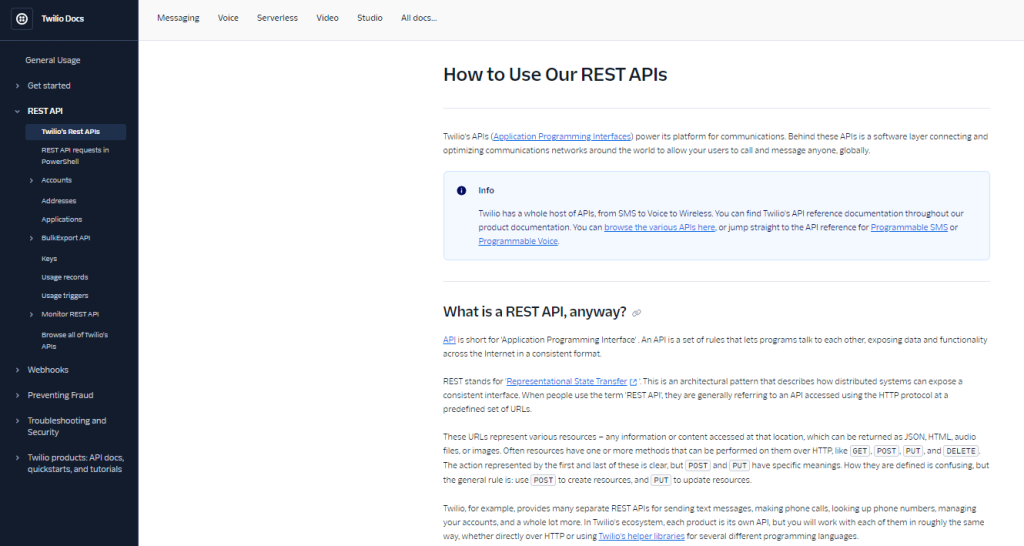
Image source: twilio.com
Twilio’s API documentation provides access to various documents, each detailing a specific product capability. The documentation incorporates practical tips, tutorials, and use cases accompanied by screenshots.
For instance, on the “SMS” page, users can find subtopics like “Getting Started” and “API Reference.” Each subtopic provides detailed information, including “How to work with your free Twilio account.” Subtopics also contain sample code for various programming languages, as well as a JSON API response.
Vimeo
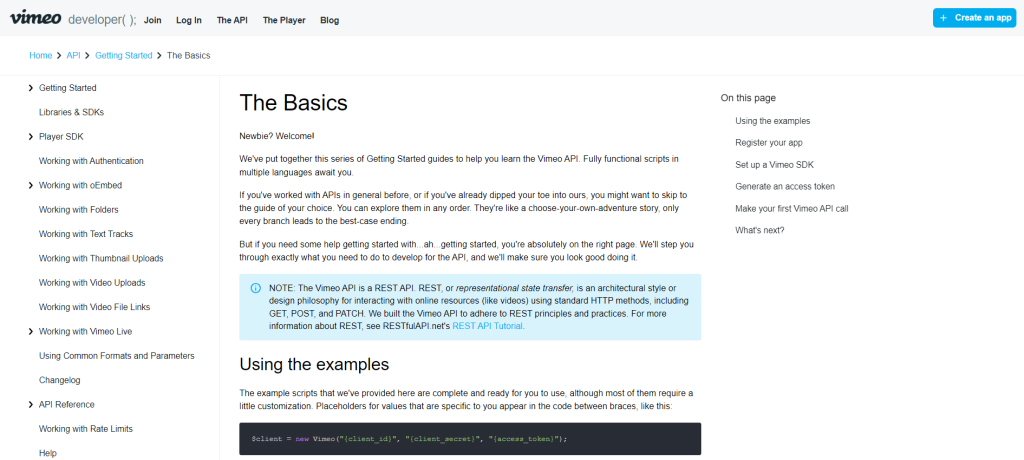
Image source: developer.vimeo.com
At first glance, Vimeo’s documentation resembles examples from other APIs, like Google Maps. Each topic page follows a three-column layout:
- A left-side menu listing document topics
- The document in the middle
- A content list on the right
However, their “Getting Started” guide stands out. It provides step-by-step instructions for setting up a Vimeo SDK (software development kit), generating access tokens, and making initial API calls. It also includes clear explanations of terms like REST (representational state transfer) and best practices for developer tools.
Stripe
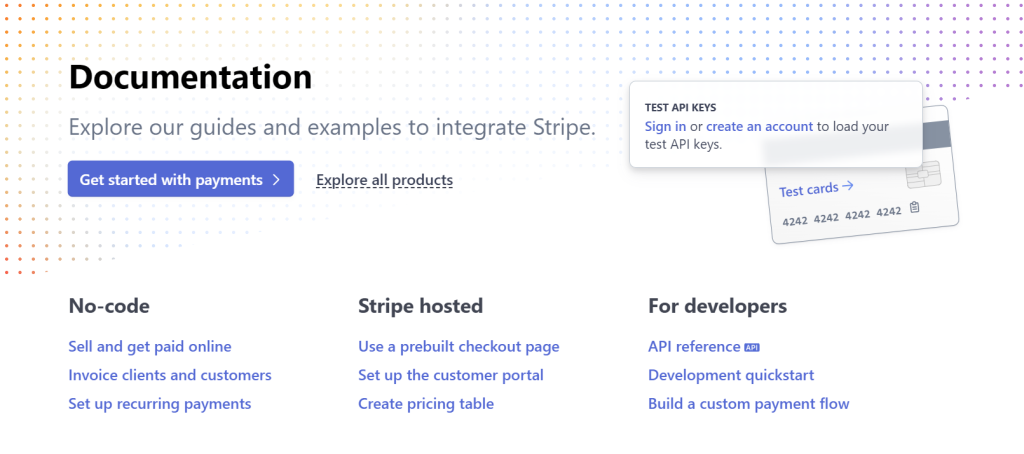
Image source: stripe.com
Stripe‘s API documentation stands out for its comprehensive tutorials, including a new interactive format. This format breaks down tasks — like embedding a Stripe payment form — into easy-to-follow guides. It also provides related code snippets for simple one-click copying. The text aligns perfectly with the nearby code module.
API documentation best practices
By this point, you likely have a deeper understanding of how to write API documentation. We asked Dmitry Erashkin, our senior back-end developer, to share some tips on how to elevate API documentation to excellence. He brilliantly cited development gurus Brian Foote and Joseph Yoder:
“If you think that good API documentation is expensive, try bad API documentation.”
Follow these practices to make your documentation stand out.
1. Use simple language
Simplicity is key when writing API documentation.
- Use plain language so developers, regardless of their skill level, can easily decode it.
- Make sure the documentation is accessible to everyone, including those with reading disabilities.
👨🏻💻 Be mindful of the API documentation generation method. Documentation generation tools excel at code comments. However, they are not as effective as real explanations written by a developer or technical writer.
2. Keep the documentation updated and accurate
Users rely on the information in the API documentation to stay in the loop. Your developers must carry out maintenance periodically to guarantee its accuracy.
- Prioritize regular updates of the documentation when changes occur in the API.
- If the API has multiple versions, include versioning information to document the changes in each version. This way, users can easily figure out which version suits their needs.
- Implement a changelog to track modifications or additions.
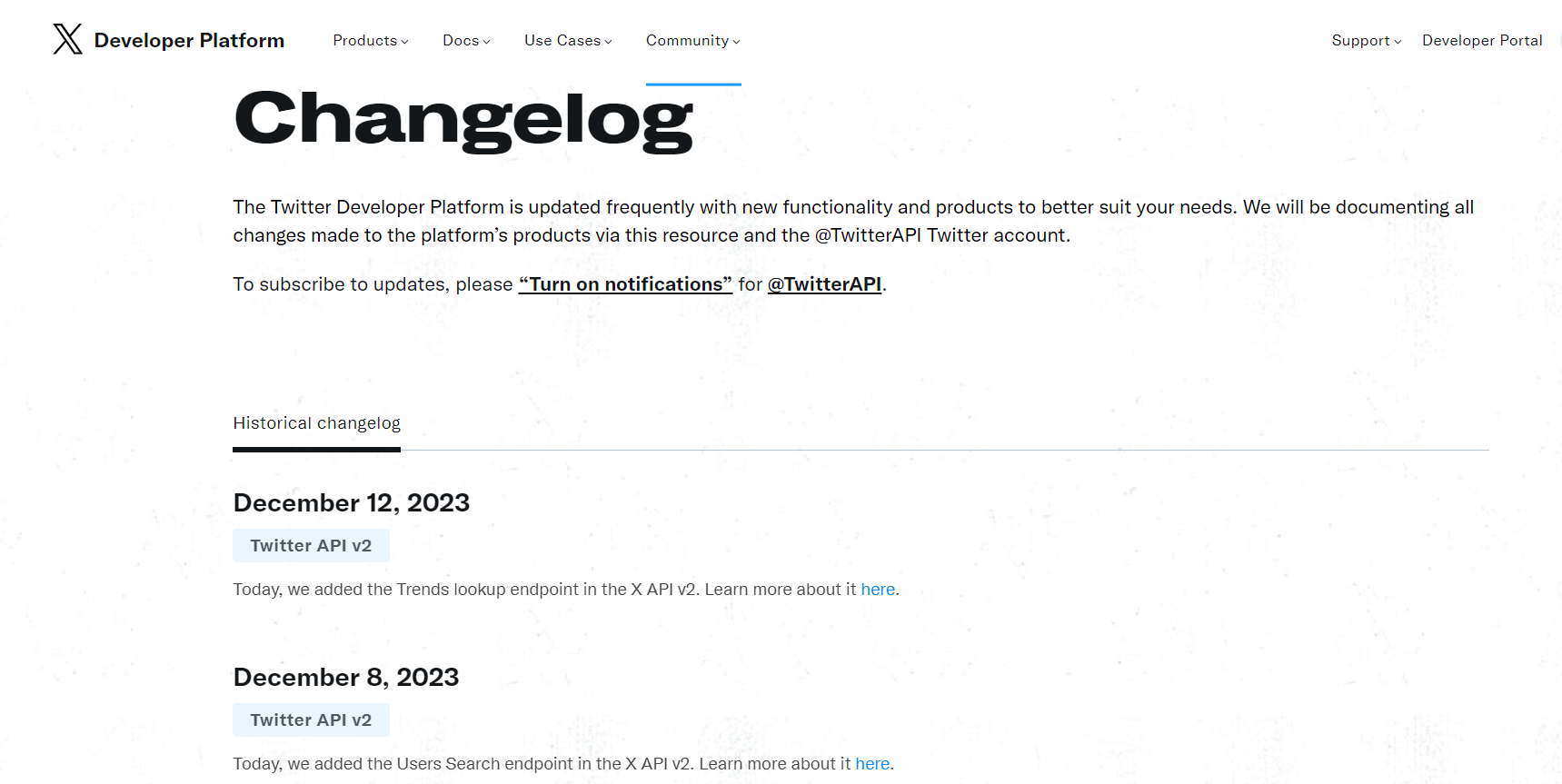
Image source: developer.twitter.com
3. Include interactive elements
Incorporating interactive elements enhances user engagement.
So go beyond the static text. API explorers or sandboxes, for instance, allow users to test endpoints in real time. They can also make learning more dynamic.
4. Implement a feedback mechanism
Effective API documentation management involves a two-way street for communication. You should not only share information but also invite user feedback.
- Include a comment section or a feedback form within the documentation.
- Utilize user feedback to continuously improve your documentation.
5. Provide contact and legal information
Your documentation should contain information on user support and legal transparency.
- Include a section for frequently asked questions and common issues that may arise when using the API documentation, along with their solutions.
- Provide information for technical support or a forum where developers can ask questions and share information regarding the API documentation.
- Clearly state the terms of use, privacy policy, and any legal information related to the API use.
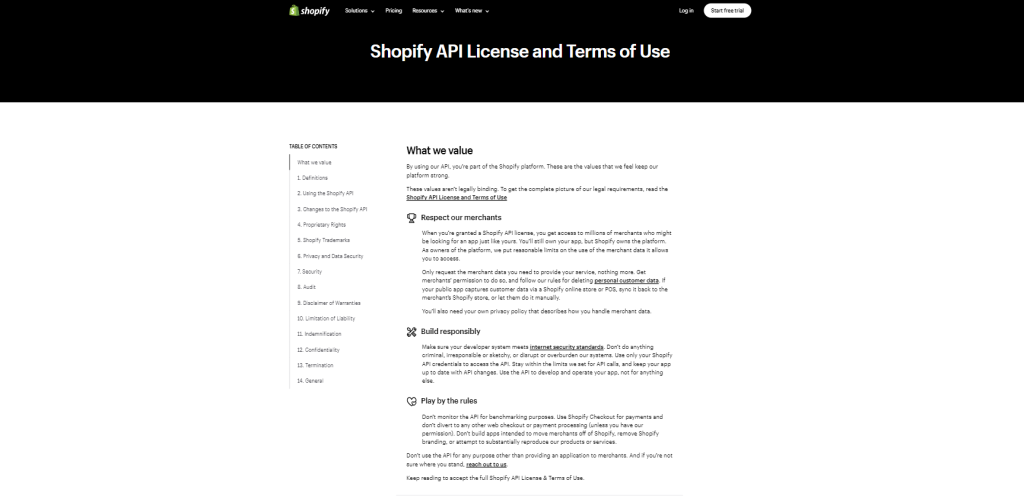
Image source: shopify.com
6. Offer extra resources
Think of which extra resources may complement your API documentation.
See if you can include code samples and SDKs for well-known programming languages linked to your documentation.
Ready to start writing API documentation?
While the API serves as the link between an application and its backend code, documentation acts as the bridge connecting the API with developers.
Creating great API documentation is no easy task, often involving an ongoing cycle of feedback and revision. Prioritize a user-friendly structure and keep the content updated to ensure your API documentation hits the mark.
Frequently Asked Questions (FAQs)
API documentation usually requires a team effort.
Developers write the technical parts, including code samples and endpoint details. Technical writers then edit and expand this material, adding explanations, guides, and best practices to improve usability.
The best programming language for writing an API depends on your project requirements, performance needs, and team expertise.
Python and Node.js are great for rapid prototyping and development, while Java and Go provide strong performance and concurrency support.
The best API documentation tool is one that balances interactivity and maintainability.
Swagger UI allows developers to explore APIs directly in the browser with live testing capabilities, while ReDoc offers a customizable experience with easy navigation.
Begin the documentation with an overview of the API’s purpose. Next, break down the content into endpoint sections. For each route, indicate the HTTP method (such as GET or POST), the endpoint path, and a concise explanation of its role.
Detail all inputs, including parameters, headers, and body fields. Then, include sample requests along with the full response format. Mention the required authentication approach and any rate limits that apply.
Follow this with a complete list of possible status codes and error messages. At the end, add a quick start guide to help users try it out immediately.
Related articles
Top 10 benefits of online texting services you haven’t considered
Texting is the pinnacle of convenience for instant c...
5 SMS compliance policy templates every business should use
From opt-in and opt-out procedures to content and fr...
12 Proven strategies to improve your customer service in 2025
Good customer service is a critical differentiator t...
Successfully outsource customer service using 8 tips we tested ourselves
Poor customer service impairs user experience and un...
SMS for healthcare: How to improve patient care with text messaging
Text messaging’s main appeal lies in its acces...




